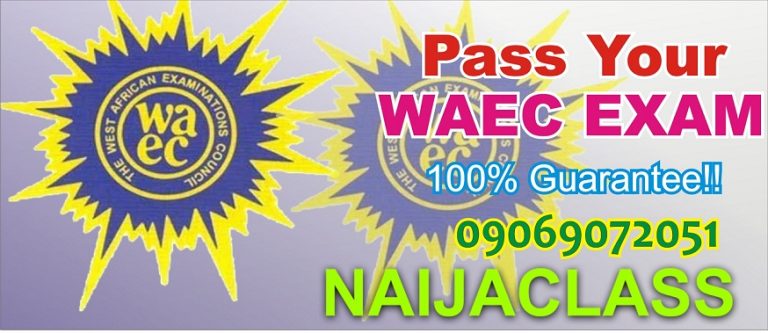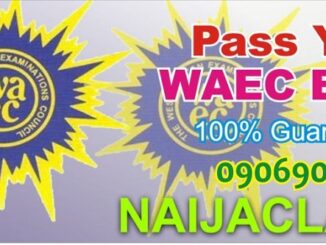Welcome to “Naijaclass Academy“ For Waec 2025 Marketing Questions & Answers

Wednesday, 14th May 2025
Marketing 2 (Essay), 2:00pm – 4:00pm
Marketing 1 (Objective), 4:00pm – 4:50pm
——————————
MARKETING OBJ:
01-10: DDDCBAABBA
11-20: BCBDDCDDBB
21-30: ACCCADCBAA
31-40: BACDBCCCCB
NUMBER ONE
(1a)
(i) Industrial printer
(ii) Packs of noodles
(1b)
(PICK FOUR ONLY)
(i) The industrial printer is a capital good, WHILE the packs of noodles are consumer goods.
(ii) The industrial printer is intended for business use, WHILE the noodles are intended for personal consumption.
(iii) The industrial printer is a durable item, WHILE the noodles are perishable.
(iv) The purchase of the printer involves a formal procurement process, WHILE the noodles can be bought casually from a retail store.
(v) The printer serves productive purposes in the company, WHILE the noodles serve a consumptive purpose at home.
(vi) The printer is a long-term investment, WHILE the noodles are used up quickly and offer immediate satisfaction.
(1c)
(PICK FIVE ONLY)
(i) Problem recognition: Mr John realized he needed to provide food for guests at his daughter’s birthday party.
(ii) Information search: He began to seek information on different types or brands of noodles available.
(iii) Evaluation of alternatives: He compared different noodle brands based on taste, price, quantity, and nutritional value.
(iv) Purchase decision: He decided on a specific brand and quantity of noodles that best met his needs and budget.
(v) Purchase action: He proceeded to the market or store and bought the noodles.
(vi) Post-purchase evaluation: After the party, he assessed whether the noodles satisfied the guests and met expectations.
(vii) Feedback and reflection: Mr John considered whether he would buy the same brand again in the future based on his experience.
(viii) Influence of experience: His satisfaction or dissatisfaction will influence his future purchasing decisions for similar occasions.
=====================================
WAEC MARKETING
NUMBER TWO
(2a)
Sales promotion is a marketing strategy used to boost the sales of a product or service through short-term incentives such as discounts, gifts, or contests to attract customers and encourage immediate purchase.
(2bi)
Coupon: A coupon is a certificate or digital code that offers customers a discount or rebate on a product or service when presented at the time of purchase. It encourages buyers to try a product or make repeat purchases.
(2bii)
Sample: A sample is a small portion or trial package of a product given free to consumers so they can try it before buying. It is often used to introduce new products and build consumer trust.
(2biii)
Premium: A premium is a promotional item or gift offered for free or at a reduced price when a customer purchases a product. It acts as a reward or incentive to increase sales and customer loyalty.
(2biv)
Contest: A contest is a promotional activity in which participants compete for prizes based on skill, creativity, or knowledge. It engages consumers and increases brand visibility and excitement around a product.
(2c)
(PICK FIVE ONLY)
(i) Magazines have a long shelf life, allowing ads to be seen by multiple readers over time.
(ii) They offer high-quality printing and visuals, which enhance the appeal and professionalism of advertisements.
(iii) Magazines target specific audiences, making it easier for advertisers to reach a particular market segment.
(iv) They allow for detailed and in-depth product descriptions due to more space compared to other media.
(v) Advertisements in magazines are more likely to be noticed as readers spend more time reading.
(vi) Magazines are considered credible sources, and ads within them are often viewed as trustworthy.
(vii) They offer creative flexibility in ad design, including full-page spreads, inserts, and cover placements.
(viii) Magazine ads can reinforce brand image through repeated exposure in multiple issues.
=========================================
WAEC MARKETING
NUMBER THREE
(3a)
(PICK FIVE ONLY)
(i) Bulk breaking: Distributors buy in large quantities from the manufacturer and break them into smaller units for retailers.
(ii) Warehousing: They store goods until they are needed by retailers or customers.
(iii) Financing: Distributors provide funds to the manufacturer by paying for goods in advance or on delivery.
(iv) Risk bearing: They bear risks such as damage, theft, or obsolescence of goods while in transit or storage.
(v) Market coverage: Distributors help extend the reach of the manufacturer’s products across various regions.
(vi) Promotion: They help in the promotion of goods through local advertising and offering incentives to retailers.
(vii) Information feedback: Distributors provide the manufacturer with market information, customer feedback, and competitors’ activities.
(viii) Transportation: They handle the delivery of goods from their warehouses to retailers or end users.
(3b)
(PICK FIVE ONLY)
(i) Nature of the product: Perishable or fragile goods may require faster and more protective transport, like air or refrigerated trucks.
(ii) Cost of transportation: The company would consider the most cost-effective method within budget.
(iii) Distance to be covered: Long distances might require rail or air transport, while short distances may use road transport.
(iv) Speed of delivery: Products that need urgent delivery would require faster means like air transport.
(v) Availability of transport mode: The company would choose based on the available transport options in a given area.
(vi) Security and safety: The company would prefer a transport mode that ensures goods arrive safely and in good condition.
(vii) Volume and weight of goods: Large or heavy products might require rail or sea transport due to capacity.
(viii) Accessibility of destination: Remote or rural areas may limit choices to specific transport modes, like road.
=========================================
WAEC MARKETING
NUMBER FOUR
(4a)
A market union is an organized association of traders and businesspeople in a particular market who come together to protect their interests, regulate trade practices, and ensure the smooth operation of market activities.
(4b)
(PICK FOUR ONLY)
(i) Regulation of member activities: The union ensures that members adhere to market rules and regulations.
(ii) Conflict resolution: It settles disputes among members or between members and customers.
(iii) Price control: The union helps to fix the prices of goods to avoid unfair competition.
(iv) Financial support: It may provide loans or contributions to members during emergencies.
(v) Information dissemination: The union provides members with important updates on government policies and business opportunities.
(vi) Security arrangement: It helps in organizing market security to protect goods and traders.
(vii) Promotion of unity: The union encourages cooperation and teamwork among members.
(viii) Training and education: It organizes workshops and seminars to improve members’ business skills.
(4c)
(PICK FIVE ONLY)
(i) Protection: Packaging protects the product from damage, spoilage, and contamination.
(ii) Attraction: It enhances the appearance of the product and makes it attractive to customers.
(iii) Identification: Packaging helps to distinguish a product from others through branding and labeling.
(iv) Promotion: It serves as a promotional tool with printed information and an appealing design.
(v) Convenience: Packaging makes it easy to handle, carry, and use the product.
(vi) Information: It provides details like ingredients, expiry date, and usage instructions.
(vii) Preservation: Packaging helps in preserving the product’s quality and extending shelf life.
(viii) Competitive advantage: Unique and quality packaging gives the product an edge in the market.
=======================================
WAEC MAKERTING
NUMBER FIVE
(5a)
E-marketing, or electronic marketing, refers to the use of the internet and digital technologies to promote and sell products or services. It involves online advertising, email marketing, social media, and search engine optimization.
(5b)
(PICK ANY FOUR)
(i) Cost-effective compared to traditional marketing.
(ii) Reaches a wider, global audience.
(iii) Enables targeted advertising and personalization.
(iv) Provides measurable results and analytics.
(v) Available 24/7, offering convenience to customers.
(vi) Enhances customer engagement and interaction.
(vii) Quick and easy updates or changes to campaigns.
(viii) Increases brand visibility through SEO and social media.
(5c)
(PICK ANY FIVE)
(i) To expand their customer base.
(ii) To increase revenue and profitability.
(iii) To reduce dependency on local markets.
(iv) To achieve economies of scale.
(v) To gain a competitive edge globally.
(vi) To take advantage of growth opportunities in emerging markets.
(vii) To build international brand recognition.
(viii) To utilize excess production capacity.
(ix) To diversify market and currency risks
================================================
WAEC MARKETING
NUMBER SIX
(6ai)
Supply: Supply refers to the quantity of goods or services that producers are willing and able to offer for sale at different prices over a given period.
(6aii)
Wants: Wants are the desires for specific goods or services that satisfy human needs and are shaped by culture, personality, and marketing efforts.
(6b)
=WOX LTD (MARKETING AND PRODUCT CONCEPTS)=
(PICK TWO ONLY)
(i) Customer orientation: The focus is on identifying and meeting the needs and wants of consumers.
(ii) Product quality: Emphasis is placed on producing high-quality and innovative products.
(iii) Long-term relationship: Building lasting relationships with customers is prioritized.
(iv) Market research: Regular market research is conducted to understand consumer behavior and trends.
(v) Customer satisfaction: The success of the business is measured by how well customers’ expectations are met.
=MANTI LTD (PRODUCTION AND SELLING CONCEPTS )=
(PICK TWO ONLY)
(i) Production efficiency: The focus is on producing goods in large quantities at low cost.
(ii) Product availability: Ensuring products are widely available is a key to business growth.
(iii) Aggressive selling: Strong promotional and selling efforts are used to push products to consumers.
(iv) Sales volume focus: Success is measured by the volume of sales rather than customer satisfaction.
(v) Little market feedback: Less attention is paid to consumer preferences or feedback during production.
=============================================
How to get 2025 WAEC Questions and Answers before the exam?
==================
It is important to note that Naijaclass.com is the only website that has the above listed 2025 Waec Expo Daily Subscription Package. However, any website who copy any of the packages listed above will be reported for content theft and have their site removed from Google and other search engines.
==================





Please can I join you and get marketing and Civic questions tomorrow early morning if I paid
If i send card for literature will i get all other subjects?
THANKS